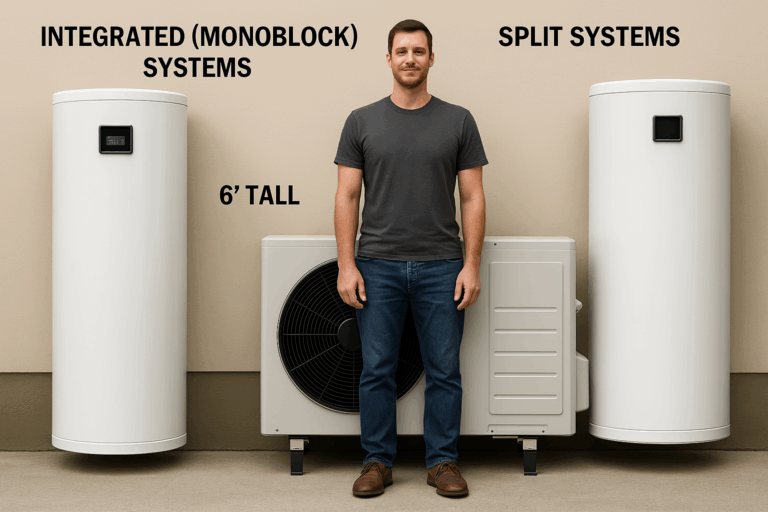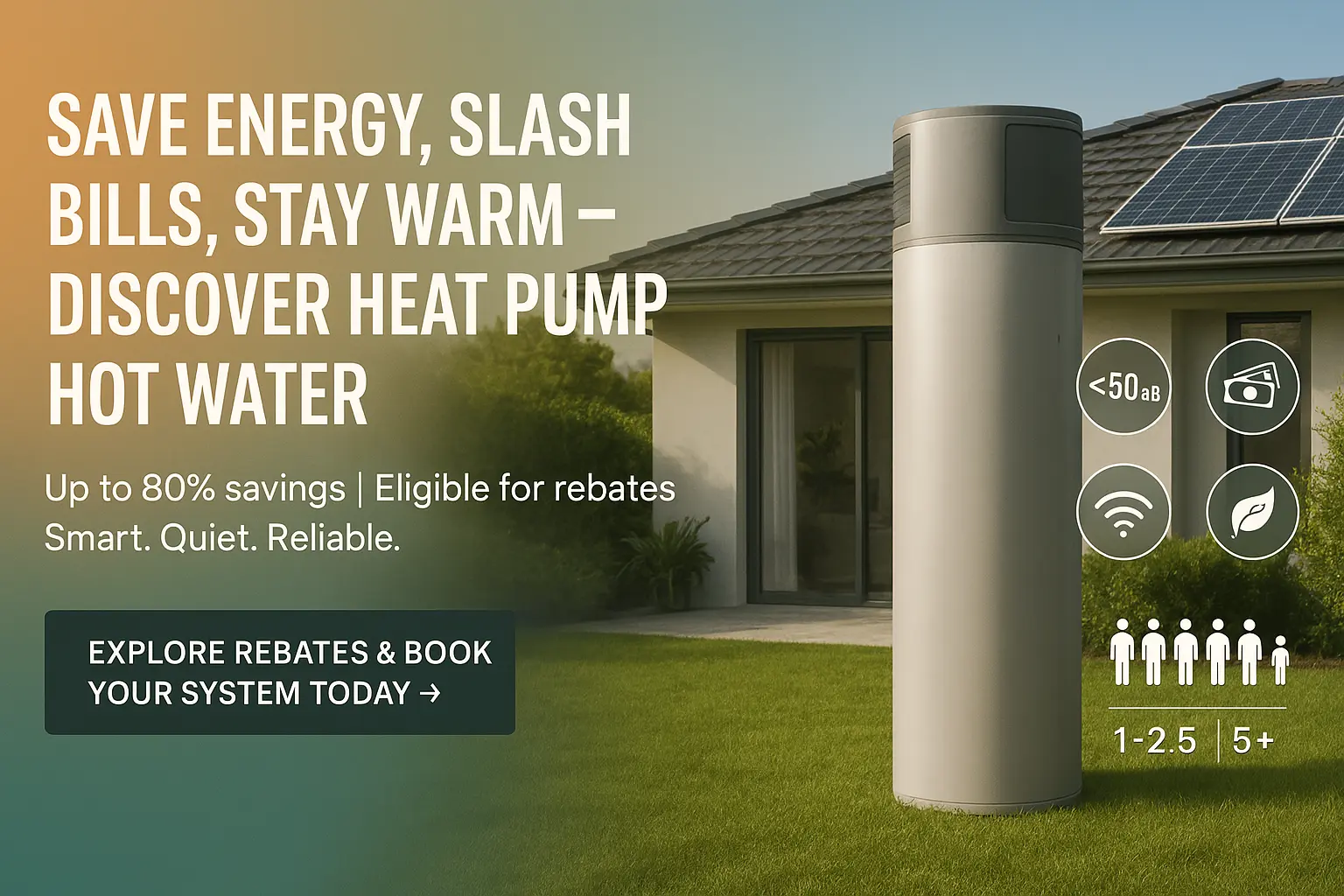The Ultimate Guide for Energy-Efficient Hot Water
Are your energy bills heating up faster than your water?
Heat pumps can slash your hot-water energy use by up to 80%. Heat pumps are significantly more energy-efficient than traditional electric resistance or gas hot water systems, often using 60-75% less electricity. This translates to substantial savings on your power bill.
With enhanced government rebates, improved technology, and proven long-term savings, heat pump hot water systems represent the optimal choice for most Australian households in 2025. The combination of 70% energy savings, substantial rebates (upto $3,000 in Victoria), and environmental benefits make these systems an excellent investment for sustainable water heating.
The key to success lies in choosing appropriate system sizing, ensuring professional installation compliance, and maintaining the system properly for optimal long-term performance.
Heat pump hot water systems are particularly beneficial when:
Replacing electric resistance systems for maximum savings
Located in climate zones suitable for year-round operation
Seeking long-term energy cost reduction and environmental benefits
Adequate space available for proper installation and maintenance
Integration with existing or planned solar PV systems desired
Key Benefits
Lower Running Costs: Up to 80% energy savings vs electric systems; ~$185/year vs $820 for resistive systems.
Environmental Impact: Cuts greenhouse gases significantly, especially with solar integration : Consider the type of refrigerant used. Modern heat pumps increasingly use eco-friendly refrigerants with a low Global Warming Potential (GWP), such as R290 (propane) or R744 (CO2). Older refrigerants like R134a have a higher GWP.
Longevity & Reliability: Lasts 10–20 years with low maintenance .
Quiet, Safe, Space‑friendly: Operates under 50 dB, no combustion risks, compact footprint .Compressor noise (~50 dB) — site away from bedrooms .
Solar Compatibility: Pair with solar panels or “solar‑sponge” tariffs to maximise free energy
Professional Installation: Always use a licensed and accredited installer who understands Australian standards. For systems involving refrigerant, the installer must have an ARCtick license. If converting from gas, a licensed gasfitter is also required to decommission the old system safely.
Key Features to Consider When Choosing a System
Capacity :
Choose a tank size appropriate for your household’s hot water usage. A general rule of thumb is around 50 litres per person per day, plus a buffer for peak usage.
System sizing depends on household hot water needs and usage patterns. Heat pump water heaters are typically measured in tank capacity:
| Household Size | Recommended Capacity | Typical Dimensions (W×D×H) |
| 1-2 people | 200-250L | 70cm × 80cm × 120cm |
| 3-4 people | 250-300L | 90cm × 100cm × 140cm |
| 5+ people | 300L+ | 100cm × 120cm × 170cm |
Note : Clearance of 30-50cm is typically required around the unit for proper ventilation and maintenance access.
Usage Patterns:
We can also fator- in usage per person when sizing and scheduling a hot water heat pump.
| Household Size | Typical Hot Water Use (liters/person/day) | Notes |
| 1 person | 50 | Higher due to no sharing |
| 2–4 people | 40–50 | Slightly lower per person |
| 5+ people | 30–40 | More efficient per person |
Noise level (dBA)
Although quieter, consider placing the unit away from bedrooms or sensitive neighbour areas to minimise any operational noise.Modern heat pumps are quiet (under 50 dB), similar to a refrigerator or air conditioner, and pose no combustion risks, offering a compact footprint. To minimize operational noise from the compressor, site the unit away from bedrooms and sensitive neighboring areas. Look for models with noise reduction technology.
Efficiency (COP)
Coefficient of Performance of 3–5 (300–500% efficient)
High COP (Coefficient of Performance): Coefficient of Performance (COP), which represents the ratio of heat output to electrical energy input . This is a crucial metric, indicating how much heat energy the unit produces for every unit of electricity it consumes. A higher COP means greater efficiency and lower running costs. Look for COPs typically between 3 and 5, or even higher for some advanced models.
This translates to using up to 70% less energy than conventional electric hot water systems.
Warranty
Typical warranties range from 5-7 years on the unit and 5-15 years on the tank.
Common options include glass-lined enamel and stainless steel. Stainless steel tanks often come with longer warranties. Look for comprehensive warranties covering both the heat pump unit and the tank.
Climate suitability
Australia has diverse climates. Heat pumps excel in Australia’s diverse climates, operating efficiently even in sub-zero temperatures (down to -7°C, some split systems to -32°C).
Climate Rating: Ensure the unit is rated for your region’s minimum ambient temperatures. While efficient in cold, reliance on the electric booster element (if present) increases running costs.
Corrosion Protection (Coastal Areas): For salty conditions, glass-lined tanks are essential to prevent corrosion. Verify its presence and maintenance needs.
Reheat Rate: Important for high-demand households or colder conditions, as reheat can be slower.
Defrost Cycle: Critical in colder areas to prevent ice buildup on the compressor, which can reduce efficiency.
System Types

Integrated (Monoblock) Systems
Combine the compressor and water tank in one unit, offering easier and cheaper installation with compact design suitable for limited spaces.
Split Systems
Feature separate heat pump unit and storage tank, providing more flexible installation options and better performance in challenging climate conditions. Split systems can operate effectively in extremely cold conditions down to -25°F (-32°C).
Rebates and incentives available
Typical Pricing starts from $2,000–$4,000 for unit, plus $500–$1,500 for installation (total $2,500–$5,500 pre-rebate).If you are an eligible Victorian household installing an eligible heat pump or solar hot water system, you can potentially combine all three rebates. While the exact total will vary, here’s an estimated range:
STCs: ~$800 – $1,200
VEECs (VEU): ~$1,000 – $1,600
Solar Victoria Hot Water Rebate: Up to $1,000 (or $1,400 for locally made)
This means your total rebate could realistically be in the range of $2,800 to over $4,000, significantly reducing the out-of-pocket expense for your new energy-efficient hot water system.
Return on Investment
Payback within 3–6 years, then net long-term savings .
Smart Features & Controls
Smart Connectivity (Wi-Fi): Remote control and monitoring via mobile app for convenience.
Timers: Program operation for energy savings, leveraging solar power or off-peak tariffs.
Solar PV Compatibility: Integrate with rooftop solar to maximize self-consumption and savings.
Off-Peak Tariff Optimization: Program heating cycles to align with cheaper electricity periods.
Heat pumps are a smart investment—cutting energy bills, reducing emissions, and supported by rebates. Other factors to consider shall be quotes, compare brands, solar options ,and evaluate local climate.
We ask that you consider us to facilitate the simplification of these processes.
Do Heat pump need periodical maintenance ?
Monthly Tasks:
Monitor water level in tank (keep at least two-thirds full)
Check pressure gauge readings
Ensure condensate drain is clear
Every 3 Months:
Check and clean air filters to maintain optimal airflow
Remove dust and debris from filters
Annual Requirements:
Professional service by qualified technician
Inspect all electrical connections
Check seals and gaskets for wear
Examine compressor, expansion valve, and fan motors
Test for signs of corrosion or leaks
Do heat pumps work in cold weather?
Ensure backup heating if in cold area. Performance drops below ~5 °C; may require backup element.
What are frequent Problems and Solutions ?
These could be :
Insufficient Hot Water
Check thermostat settings and calibration
Assess if system size matches household demand
Flush tank to remove sediment buildup
System Not Turning On:
- Verify power supply connection
- Check electrical panel for tripped breakers
- Examine thermostat settings
- Look for visible damage such as frayed wires or leaks
6. Electrical Issues:
- Inspect electrical connections for looseness
- Check thermostat and heating elements functionality
- Use multi-meter for fault testing
- Always turn off power before electrical work
How long do they last?
With fewer moving parts than gas systems, HWHPs are generally durable, with an average lifespan of 15-20 years (some even up to 25 years).
What is the payback period?
With rebates and ~A$700–1,500 yearly savings, break–even in 3–5 years.
The main disadvantage remains higher upfront costs compared to conventional systems. However, long-term energy savings typically offset initial costs within 2-4 years, and enhanced government rebates significantly reduce the financial barrier.
What's the COP for this model?
While modern systems work effectively in cold climates, efficiency decreases in extremely cold conditions. Field studies indicate actual efficiency may be 65-75% of manufacturer ratings in very cold climates. However, Australian climate conditions make heat pumps suitable for most regions.
What's the estimated annual running cost for my household?
Up to 80% energy savings vs electric systems; ~$185/year vs $820 for resistive systems.
Is it eligible for STCs/state rebates?
Yes , these products are elgible for rebates under various schemes SRES ( Federal goverment ), VEU ( vfictoria state ) and Solar victoria. This depending upon type of installation.
What's the warranty on both the unit and the tank?
Under VEU scheme, there shall be minimum standard warranty of 4 years.
Where will it be installed, and how will ventilation/noise be managed ?
If this is not acknowledged, it can lead to challenges :
Well-ventilated outdoor location preferred
Proper drainage for condensate and overflow
Adequate clearance for airflow and maintenance
Positioning away from bedrooms due to noise considerations
Proper insulation of all hot water pipework
Dedicated electrical connection
Are there any legal Noise Regulations ?
Yes, Heat pumps and air conditioners should not exceed 45dB(A) between 7am-10pm or 40dB(A) between 10pm-7am, measured one metre from the external wall of neighbouring premises. Proper positioning and planning with neighbours is essential for compliance and good relationships.
Systems produce noise similar to air conditioners, requiring careful positioning away from bedrooms and neighbour boundaries.
Can we integrate Hot water heat pump with Solar Systems ?
Yes, you can plus you can get additional rebate under variuos schemes. Heat pumps work excellently with solar PV systems, allowing excess solar energy to power the heat pump during peak generation hours. This combination maximizes both environmental benefits and cost savings by utilizing renewable energy when available.

